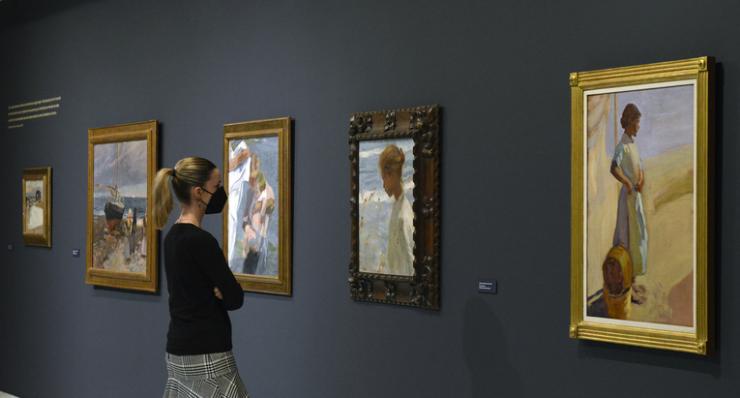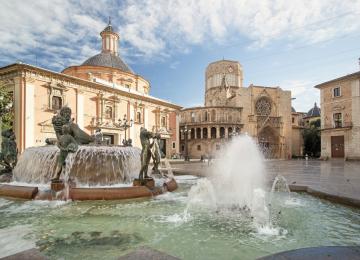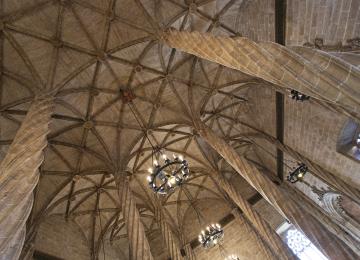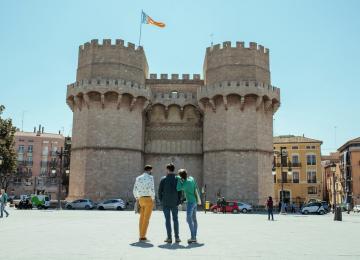Must-see museums for your trip to Valencia
If you're an art lover, enjoy discovering a wide range of creations and adore museums, both inside and out, Valencia has some sure bets for you.
Because Valencia has museums where the building itself is a work of art, housing examples of every artistic style. What’s more, they're located in essential areas of Valencia for visitors, a real plus, for sure.
To help you make the (difficult) decision of which Valencia museums to visit, we've put together a varied selection of the best to give you an idea why they're worth a look, what you’ll find there and which of the city's can't miss sights you can combine them with.
Off we go!
Valencia’s top museums
As we said, our selection includes options representing various artistic disciplines so you can choose the best one for you: painting, sculpture, ceramics and even art for the Fallas festival all await at Valencia's museums.
Let’s dive in.
#1 Museum of Fine Arts
San Pío V, 9
We start off strong with Spain’s second largest art museum: the Museum of Fine Arts.
Its current headquarters is the former Colegio Seminario de San Pío V, founded in 1683, which is located on the banks of the River Turia.
The building and its surroundings are a gift for the senses in themselves. If you can, head down to the river for a stroll before or after your museum visit.
What will you find inside?
This Valencia museum boasts an extensive selection of paintings, sculptures, engravings and archaeological pieces dating from the 15th to the 19th centuries.
If there is one thing the collection is noted for, it is paintings by such prestigious Valencian creators as Sorolla, Ribalta and the Pinazos, among other local artists who displayed great mastery of light.
Not to mention works by none other than the geniuses Van Dyck, Murillo, Velázquez, El Greco and Goya.
To finish this visit in style, be sure to make a stop in the Courtyard of Ambassador Vich, located inside the museum. This Renaissance cloister has been exquisitely reconstructed, and the predominant colour is an unexpected blue.
Another bonus is that admission to this Valencia museum is free. It is open 10am–8pm, every day except Monday.
#2 Carme Contemporary Culture Centre
Museo, 2
The Carme Contemporary Culture Centre (CCCC) is in the heart of El Carmen neighbourhood, the most colourful area of the city. What is more, it owes its name to the fact that it is housed in the former Nuestra Señora del Carmen de València Royal Monastery.
This is probably the most diverse of the city's museums, mixing styles and techniques ranging from art installations to painting, along with design, literature and graffiti: there is space for everything.
And this is precisely what makes it interesting. A visit to the CCCC is an active experience for all ages, as it even includes a gallery for the little ones: the Espai de Titelles, designed for children aged 0 to 3.
Take advantage of your visit to the heart of El Carmen neighbourhood to stroll along its side streets, sip a vermouth, eat at an outdoor café, admire the medieval towers and discover its mansions.
When can you visit the culture centre?
The centre’s opening hours are Tuesday–Sunday, 11am–9pm. Entry is free.
#3 Bancaja Foundation
Plaza de Tetuán, 23
The Bancaja Foundation is a private not-for-profit organisation. In addition to putting together temporary exhibitions, it boasts a collection which the foundation describes as a ‘catalogue of masterpieces’.
And this should come as no surprise. Its most notable pieces include prints by Picasso and Valencian artist Joaquín Sorolla, two national and international heavyweights.
While you're in Valencia, check out the current exhibitions at the time of your visit. They're normally incredibly interesting. To give you an idea, its galleries have hosted exhibitions on Chillida and others devoted to industrial design, as well as shows featuring such artists as Antonio López, Julio Romero de Torres, Sorolla and Picasso, to name just a few.
This Valencia museum also organises activities for all ages, including workshops, lectures and performing arts festivals, making it a truly vibrant space.
The building is a stone’s throw from the historic district and Colón Street, the city's biggest shopping street, if you’d like to take the opportunity to do a bit of shopping or simply go for a walk. Valencia's centre has a range of architecture that is well worth a look.
The foundation is open 10am–2pm and 4.30pm–8.30pm, Tuesday–Sunday. There are two ticket prices: general admission, which is €7, and reduced, which is €4. Children 12 and under are free.
#4 National Museum of Ceramics
Rinconada García Sanchiz, 6
Pottery and ceramics are an essential part of Valencia’s DNA, with a tradition dating back a mere 7000 years. This makes the González Martí National Museum of Ceramics and Decorative Arts among Valencia’s most special.
It could actually be said to be two in one, as the first floor gives a very tangible glimpse into the 18th-century aristocratic lifestyle, having been completely refurbished in that century, although it was built in the 15th.
Before heading up to visit the museum, pause to take in the incredible sight of the Palace of the Marquis de Dos Aguas and its baroque façade.
Once inside, you can visit such galleries as the Ballroom and the Red Room, see the Carriage of the Nymphs, spectacular staircases, elaborate coffered ceilings, and the painting collection of González Martí. Can you imagine what it must have been like to live in a place like this?
And then there is the pottery collection, a journey through human history. There are pieces produced by different cultures, from the Romans, Greeks and Iberians to the present day. This is why we referred to it as two museums in one.
The National Ceramics Museum is located between Valencia's most commercial district and other must-see sights: the Central Market area and the Silk Exchange, a World Heritage Site.
Hours are Tuesday–Saturday, 10am–2pm and 4pm–8pm; Sunday and holidays, 10am–2pm.
If you're planning to visit in what’s left of 2021, admission is free. If you come after that, general admission will be €3, and reduced-price tickets will be €1.50. In any case, it's always better to check before visiting.
#5 El Patriarca or Corpus Christi Royal School/Seminary
La Nave, 1
How about the names Caravaggio, Juan de Juanes, El Greco, Morales and Ribalta, do they ring a bell? You’ll find them all and other artists of their stature at the Corpus Christi Royal School/Seminary, also known as El Patriarca.
As the name indicates, the building was constructed for use as a seminary between 1586 and 1615. Buuuut, since 1959 it has also been a museum displaying the vast collection accumulated over the centuries.
Once again, in addition to its contents, this is another museum whose building is a must-see in itself. If you come in through the main entrance, you will enter a double lobby leading to … that depends!
If you turn to the left, you’ll see an enormous stuffed alligator. Yes, you read that right, a real alligator brought back by a mission to the Americas with a curious legend. It is posted there like a guard before the chapel. But don't let that stop you from entering, or you will miss the extremely valuable frescoes and the high altar presided over by a Last Supper by Ribalta.
And on the other side of the lobby?
To the right lies one of the oldest Renaissance cloisters in Spain, with a courtyard, columns and arches accompanied by a ceramic tile plinth course, not a surprising feature in Valencia. The entrance to the museum is just to the right of the courtyard.
When you finish, you can stop by El Patriarca Square, right beside the complex, and stroll through such iconic streets as calle Comedias and calle de la Nave.
The museum is open mornings, Monday–Sunday, 11am–1.30pm; and afternoons, Monday–Friday only, 5pm–7pm. Tickets are €5.
#6 IVAM - Valencian Institute of Modern Art
Guillem de Castro, 118
Our tour of Valencia's most noteworthy museums continues, taking us a little way from the city centre to the bounds of the medieval walls of the capital on the River Turia.
The IVAM is a complex devoted to modern art where you can enjoy two permanent shows dedicated to two key figures in early 20th-century art: Ignacio Pinazo and Julio González.
Although its collection is unique, the IVAM’s personality cannot be understood without its temporary exhibitions, workshops, lectures, installations and events for all ages.
One gets the sense that there is always something going on at the IVAM.
Another of its attractions is the Wall Gallery. This space in the basement of the Julio González Centre contains the remains of the 14th-century medieval wall.
There is also a restaurant with a delightful outdoor seating area. We’ll leave it at that …
Where can you go after the IVAM?
A few metres away, you’ll find the Quart Towers – one of the two gates in the medieval wall still standing (the other is the Serranos Towers) – leading to El Carmen neighbourhood.
Opening hours for the Valencian Institute of Modern Art are Tuesday–Sunday, 10am–7pm, and Friday, 10am–9pm.
General admission is €6, reduced admission is €3, and children 10 and under are free.
#7 Hortensia Herrero Art Center
Calle del Mar, 31
Modern, elegant, and with a very special touch, that's how this contemporary art center is described.
It houses the private collection of Hortensia Herrero, patron and vice president of the foundation that bears her name. Additionally, it is located in the heart of the city, in the old Valeriola Palace, a emblematic 17th-century construction that is itself an architectural treasure.
The collection includes works from over 50 contemporary artists of internationally recognized prestige. Anselm Kiefer, Anish Kapoor, George Baselitz, Mat Collishaw, Tony Cragg, Andreas Gursky, Jaume Plensa, Cristina Iglesias, Joan Miró, Antonio Saura, Julio González, or Manolo Valdés, as well as pieces created specifically for the Art Center's locations that make it even more special.
Creations ranging from the avant-garde to the most innovative await you. Imagine paintings that make you question reality and sculptures that evoke emotions. A visual experience you can't miss!
The center is open from Tuesday to Saturday from 10:00 to 20:00, and on Sunday from 10:00 to 14:00. Guided tours can be reserved, and entry is free on Wednesday afternoons.
#8 La Almoina Archaeological Museum
Plaza de Décimo Junio Bruto s/n
A visit to La Almoina is a journey through the city's evolution from its founding by the consul Decimus Junius Brutus and the coming of the Roman Empire, through the Visigothic period and the Muslim era until it returned to Christian hands.
What can you see?
If you follow the standard route for the visit, you will move in chronological order, discovering the different sections and periods. Begin at the centre of the site, where you’ll find the Roman baths and ruins of the Republic-era city. Also dating from this period are the forum portico and curia building. From the Visigoths, look for the baptistery and monumental tombs. And for the Muslim period, the alcázar (fortress), waterwheel, pool and part of the fortifications.
Following all these civilisations, Jaume I reconquered the territory. The building that houses La Almoina dates from this period, a space built to provide for people with no resources. To this it owes its name.
We know you must be thinking that this archaeological complex has to be huge. And so it is: 2500 m2 where you can visualise the city's history from its earliest beginnings. If you look at it that way, it doesn’t seem so large, does it?
Another of the museum’s attractions is that it’s just around the corner from La Virgen Square, La Reina Square and Valencia Cathedral, an area packed with cultural and historic landmarks. The perfect place to get something to eat or sip a Valencian horchata (tiger nut milk).
Opening hours are Tuesday–Saturday, 10am–7pm and Sunday and holidays, 10am–2pm. Admission is free on Sundays and holidays, and tickets are €2 the rest of the week.
#9 Fallas Museum
Plaza Monteolivete, 4
Have you ever heard of a ninot?
Let’s start there: ninots are each of the satirical figures that make up the fallas (sculptures) displayed during the annual Fallas festival.
As you may know, every March, Valencia celebrates its greatest festival: Las Fallas. The culmination of the celebration is the burning of the artistic constructions that crowd the streets in preceding days, structures built over the course of the entire year.
However, since 1934, two ninots chosen by popular vote have been saved from being burnt, which have been called ninots indultats and are exhibited in this very Valencian museum.
In addition to presenting these representatives of Las Fallas, the museum shows how they have been made since the early days (we’ll share the secret: they were made of wax), the techniques used to set up the fallas, and posters and photographs from the history of this festival, which has been on the UNESCO Intangible Cultural Heritage of Humanity list since 2016.
While the best option is of course to experience Las Fallas during the week of the event itself, if you can't visit in March, the Fallas Museum is a great way to discover this unique tradition, which is sometimes difficult to grasp if you don’t see it in person.
What sights can you combine with a visit to the Fallas Museum?
Without a doubt, a stroll through the stretch of Turia Gardens between El Reino Bridge (the one with the gargoyles) and the City of Arts and Sciences should definitely be part of the plan when you visit this Valencia museum.
Walking under the bridges surrounded by gardens, parks and the occasional snack bar where you can refuel will do you a world of good.
The museum is open from Tuesday to Saturday from 10am to 7pm (last admission to the museum at 6pm) and from 10am to 2pm (last admission to the museum at 1pm) on Sundays and public holidays. Admission is €2, except on Sundays and public holidays, when it is free.
And so, we have come to the end of our journey through Valencia’s absolutely can’t miss museums. As the saying goes, ‘not all are here, nor are there here all those that are’. However, if you visit them all, you can proclaim loud and clear that you are indeed truly familiar with Valencia and its culture. And if this list has only whetted your appetite, take a look at all the other museums Valencia has to offer.















